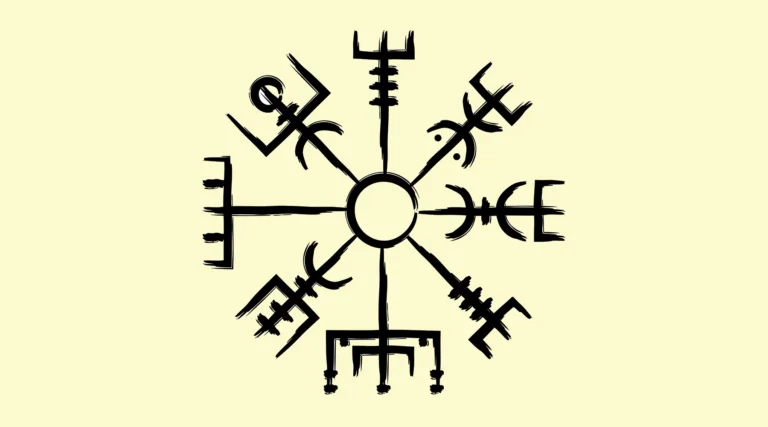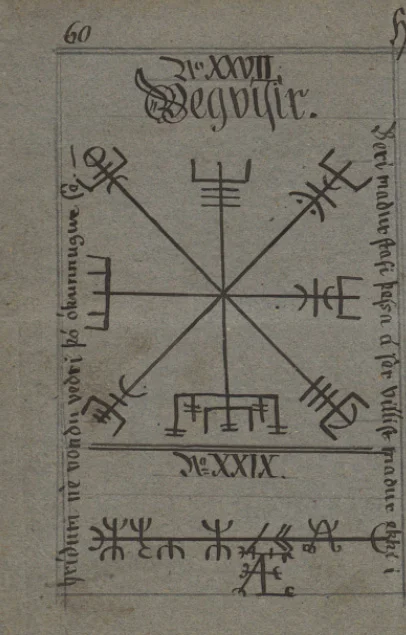The vegvísir is a commonly used viking symbol that's meant to stop people from losing their way. But is it actually from the Viking Age?
If you’re interested in viking imagery and symbolism, you will have undoubtedly seen the vegvísir.

Literally “way” (vegr) “shower” (vísir), the symbol is meant to prevent the person carrying it from losing their way, and is known colloquially as “The Viking Compass” or “The Nordic Compass”.
It can often be seen on viking-inspired tattoos, jewellery and illustrations, and even in video games, such as Valheim. Which is strange, as it’s not actually a viking symbol at all.

Norse compass or a Norse con?
The vegvísir is featured alongside a number of other galdrastafir (magical staves) in the Huld Manuscript, which was written in Iceland by Geir Vigfusson in 1860. The text around it says:
“Beri maður stafi þessa á sér villist maður ekki í hríðum né vondu veðri þó ókunnugur sá.”
“Carry this sign with you and you won't get lost in storms or bad weather, even in unfamiliar surroundings” (translation: Justin Foster)
This is the earliest instance of the vegvísir in existence. While 1860 seems like a long time ago, it’s still a far cry from the Viking Age, which ran approximately 793-1066.

To add some historical context, the 1860 presidential election in the US was won by Abraham Lincoln… but “the Abraham Lincoln Presidency Compass” has less of a ring to it.
The runic compass?
So, other than the obvious yet tenuous connection of “old and Icelandic”, how did the vegvísir become so associated with the vikings?
In his video Vegvísir (wrongly called “Viking Compass”), Norse Scholar Jackson Crawford suggests that the appearance of the symbol may play a large role:
“Sigils like ægishjálmur and vegvísir bear a certain visual resemblance to runic letters and as much as they use a lot of straight lines. Some of those particular straight lines taken together look a little bit like runes. You can arrange the ægishjálmur sigil in such a way that it has 24 points, which equates to the 24 letters in the elder futhark alphabet, but they are not runes because they do not represent letters or even words. And they might not be any older than the manuscripts in which they’re written down.”
Read more: Viking Runes: The Historic Writing Systems of Northern Europe
The Viking revival
The historical setting of the time might also have played a role in cementing the vegvisir’s viking connection.
The 1800s in Europe was characterised by national romanticism, bringing with it the “Viking revival“, which saw a renewed interest in Norse history and mythology in the Nordic region as well as Germany, the UK and the US.
For example, Richard Wagner composed his opera, Der Ring des Nibelungen (The Ring of the Nibelung), which draws from Norse mythology such as The Saga of the Volsungs, between 1848 and 1874. The opera’s costume designer, Carl Emil Doepler, single-handedly kickstarted the association of vikings and horned helmets (so cheers for that one, Carl).
Read more: The Valkyries Explained
Therefore, it’s possible that the vegvísir was also an expression of national romanticism, or at least, have received more attention because of it.
Did the vikings use a real vegvísir?
The symbol might not be from the Viking Age, but did the vikings use a real vegvísir to find their way across the seas?

As with most things related to the vikings, we don’t know for sure what they used to navigate (I know it’s frustrating, but that’s history for you). However, based on the knowledge and materials they had at the time, it’s possible that they used a solar compass.
Again, however we do not know this for sure, and a solar compass would’ve had its limitations – particularly in the North, where the sun disappears in winter.
Give me a sign
Ultimately, much like horned helmets or the Vikings TV show, the vegvísir is aesthetically pleasing but has nothing to do with the actual vikings.
That said, it’s very common to see a vegvísir being used in daily life – particularly in German-speaking countries (wegweiser means “sign(post)” in German).
Did you know that the vegvísir was not actually a viking symbol? Does this change what you think of the vegvísir? Let us know.


Thank you for this article, I enjoyed reading it. Wanted to find out how the vegvísir had to be used before buying one as wall decoration. Of cause I won’t right now.
SAME ♥️
Why not have one it’s a pleasant symbol and I have one to remind me to stay on the correct path, through my battle with mental health
I thought that was a protection sigil. Nothing can get to the center.
You may be thinking of the Aegishjalmur.
Hello, Yes it is Vikings symbol. How I know? Well in Baltic States and in Norway and in Swedel have been a lot found out about Vikings. In one ship what was found in Saaremaa Estonia were a littel stone, where this vegvisir was on . So proufes are and it is from Vikings. I dont understand why u have to say its not theirs?!
hi,do you have proof of what you saying?
I had a friend who lives in Norway educate me that this symbol even exist. He says it is seen in a lot of parts in Norway. As I understand it my be more Christian. But we all know that around 1000 Christianity was being introduced all over Scandinavia. I had someone on a FB site tell me this wasn’t part of my heritage all because it originated in Iceland. What he didn’t know is my Viking ancestor came from Iceland to Norway. So no matter if it was introduced in 1200 or 1800 I find it to still be a part of my heritage. Am I wrong to assume so?
The Runes arranged in a circle is a ‘New Age’ adaptation (?)
The central sigil isn’t runic, but includes elements from sigils belonging to an ancient magical tradition that includes Solomon’s ‘seals’, that spread from the Middle East to Europe, and on to Iceland a few centuries after the Viking Age (?)
It may be that the Phoenician pictogram for ‘a fish’ (Samekh) is included, and a symbol for ‘fog’ (a vertical line with two shorter intersecting horizontal lines) has survived in weather reports to the present day (?) Other elements appear to be astronomical or astrological, and such a combination of magical signs and symbols would be in keeping with the idea of Vegvisir being a form of compass, as the meaning of ‘veg visir’ suggests.
thanks this article is really helpful.
Thank you, great article. I would try to translate the “shower” to indicatior.
An indicator of the right way / path to take in life.
Would you agree?
Yes I agree. I have the tattoo on my arm as represents to me safety on life’s journey and protection with a sense of direction in life for me and my family. I’m mainly of English decent and still feel a strong connection to it.
I’ve had a leather cuff bracelet with Vegvisir on since my return to college (for perspective, I had a ten year unplanned absence due to constant family health issues, including my own bought of Covid.) I’ve known about the Huld connection since before purchasing the cuff and I’ve followed Dr Crawford for years, especially now having discovered I have lineage back into the Vikings with apparent ease. (My great-grandmother’s surname was McLaughlin/MacLachlan, family connections to Spencers, Stewarts, and Campbells in Scotland and Ireland. You can’t get much more descended from Vikings than that lineage.) Will it change my take on the sigil? A little, but, as with many other symbols with Viking basis or a modern homage to Vikings, a little knowledge can’t hurt. I always give the full history as I’m able, abridged or otherwise, because it’s the only way to reclaim so much of what was lost. To Nazis or otherwise. Still, given the choice between this and something that dates properly, I’d take the one that dates properly in an instant but those are hard to come by today. With rampant misinformation and easy knockoffs from the show or various games. Or Nazi symbolism right beside it and the owner doesn’t care.
I enjoyed learning the real background to this! It’s no surprise that the real meanings have been lost to time and revived – possibly in the wrong way. But since it’s so widely used in it’s current form, I will still be proud to have it on my arm. But now I will be able to tell people what it really is 🙂
If the symbol was found on a Viking ship it seems to me it may have at the very least been used by the Vikings! To say it isn’t a Viking symbol simply because it was’also’ found in English literature is a little short sighted! The Vikings raided there, hello! Cheers!
I recently read the huld manuscript was compiled in 1846 from three older manuscripts, one of which was 1810… link to manuscript is:
https://handrit.is/manuscript/view/is/IB04-0383/7?iabr=on#page/2v/mode/2up